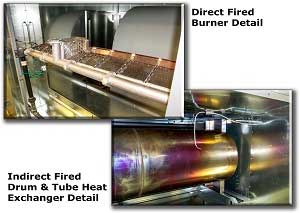8 Reasons Swimming Pool Ventilation Requires Specialization

9 Reasons Commercial Kitchen Ventilation Requires Specialization

6 Ways Air Turnover Systems Displace Costs and Better Your Work Environment

For a commercial HVAC contractor, designing a system for a natatorium or building containing a swimming pool can be especially challenging. Indoor pool areas tend to be cavernous, covering a lot of square footage and have extremely high ceilings. They also face three sources of moisture: the pool itself, the people using it, and intake air.
The goal for the HVAC contractor is to provide comfortable conditions for swimmers, staff and spectators while maintaining good air quality. Here are eight reasons why that’s a big challenge that requires a custom HVAC solution:
- Pool uses differ and require different HVAC solutions. If a pool is going to be used for therapy, the water temperature will probably be above 90°F, so the room temperature would have to be lower than the water temperature to ensure the comfort of staff and observers. In a non-therapy setting like a high school or YMCA, the water is often kept at 80°F to 82°F, allowing for the room temperature to be set a few degrees higher so swimmers are comfortable when they get out of the water. The desired temperature differential between water and air affects air-handling design.
- The facility may have zones with differing HVAC needs. Building operators may want the pool’s spectator area to be a few degrees cooler than the pool deck because parents watching their children’s swim lessons will be fully dressed; possibly wearing coats. Areas near a hot tub require ventilation that differs from the actual pool area because the heat and rapid water movement cause moisture and chemicals to be released into the air at a rapid rate. Ventilation needs can also vary from the wet pool deck area closest to the water to the dry pool deck areas.
- Chemicals in the air can cause breathing issues. Chemicals are used to keep pool water free of harmful bacteria. When someone jumps into the water at an outdoor pool – causing chemicals to disperse into the air – it’s not a problem. With an indoor pool, however, those chemicals are trapped, which is why pool areas often smell like chlorine. Without proper ventilation, there can be an unpleasant odor, and worse, inhaling the chemicals can cause respiratory problems. Chemical concentrations are the highest at the water’s surface – where swimmers breathe – so a properly ventilated pool area must balance air distribution. There should be some airflow over the water to reduce the chemical concentration where swimmers breathe but not so much as to dramatically increase evaporation. In addition, good air must get to people throughout the building.
- Outdoor temperatures have a big impact. The HVAC system requirements for an indoor pool facility in Maine will be vastly different from those for a pool in Southern California. It is a costly challenge to heat outdoor winter air in a far northern climate to 82°F, but it can be just as expensive to prevent a natatorium from becoming overheated in a southern climate.
- A moist environment. Moisture is unavoidable in a natatorium, but it must be controlled for the health and comfort of the facility’s users and to prevent mold growth and corrosive damage to the building. Moisture will condense quickly on cool surfaces like windows, fire doors and skylights. Areas like these must be identified so the system can be designed to supply enough warm air and air movement to prevent condensation. This means duct design is also vital in preventing condensation throughout your space.
- The amount of usage can vary. A college’s pool could host a swim meet for hundreds of swimmers and hundreds more spectators one day but then see little or no usage for a week when students are gone on break. Similarly, a hotel’s pool area could be significantly busier during peak tourist season or on weekends than other times of the week or year. An effective HVAC system will be designed to handle both extremes.
- Pools can be energy hogs. It takes a lot of energy to maintain water temperature, air temperature and air quality in a natatorium. A properly designed HVAC system can make a huge difference in the carbon footprint and utility bills for any building housing a swimming pool.
- Location of Equipment. It is very important that the air handler not be located directly above the swimming pool. Warm moist air migrating into the system can cause operational problems.
As an HVAC contractor, you’ll want to work with manufacturers who have experience with equipment for natatorium applications. Ask the facilities manager or building owner a lot of questions about the pool and its usage before recommending an HVAC system. The more information you have the more effective and efficient the equipment you propose can be. Regular maintenance for the system is a very important aspect that needs to be addressed. Making sure the system is always adjusted for peak performance will result in lower energy and maintenance costs in the long run. This may present an opportunity for you to sell a maintenance contract.




